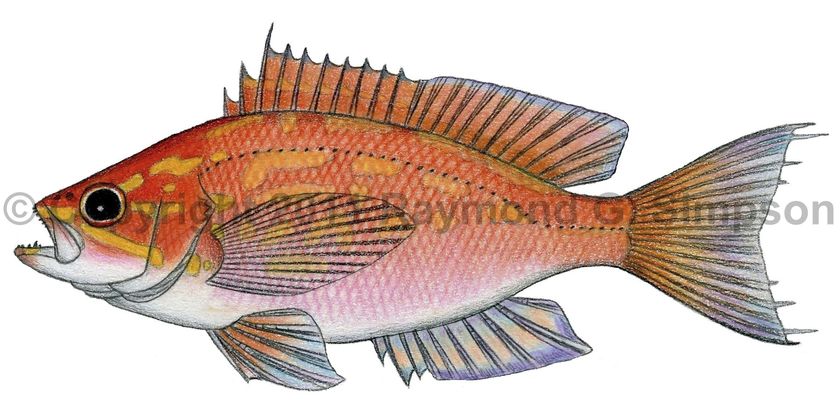
Common Name
Roughtongue Bass
Year Described
Guichenot, 1868
Identification
Dorsal Fin: X, 13-16 (usually 15)
Anal Fin: III, 7-8 (usually 7)
Pelvic Fin: I, 5
Pectoral Fin: 16-18 (usually 17)
Lateral Line Scales: 35-41 (tubed)
Gill Rakers: 9-13 in upper, 24-29 in lower limb of first arch; 34-41 total
Moderately deep body, head 31-37% SL, and eye large (9-13% SL). Orbit longer than snout. Upper and lower jaws both with conical teeth, including larger canines anteriorly. Vomerine tooth patch with an obvious posterior extension. Tongue with an oval tooth patch. Anterior nostril with a small filament (not reaching orbit). Most of head and maxilla covered in scales. Lateral line continuous. Scales around caudal peduncle 18-22. No notch at boundary of spiny and soft dorsal fin. Third dorsal spine more elongate than rest. Caudal fin crescent-shaped, often with filamentous rays. Pelvic fin short (25-35% SL).
Color
Rosy-red to red-orange body with paler scale centers on the body becoming larger ventrally. The head has a yellow stripe running under the eye and often two other yellow stripes radiating from the upper eye. These stripes become broken with scattered yellow blotches on the upper body. There is often a golden or brownish mid-body bar under the dorsal fin (especially in Brazilian populations). Fins pale yellow with rosy-red markings (with a brilliant blue sheen in living specimens).
Size
Adults common to 10cm SL. Maximum size to 17cm SL.
Habitat
Deep reefs from 55-230m. Forms aggregations near hard bottom habitats. The Brazilian population occurs in shallower waters from 8-40m.
Range
North Carolina to S. Brazil, including the Gulf of Mexico and the Caribbean Sea. Also Bermuda.
References
Anderson, W. D., Jr. & Heemstra, P. C. 2012. Review of Atlantic and eastern Pacific anthiine fishes (Teleostei: Perciformes: Serranidae), with descriptions of two new genera. Transactions of the American Philosophical Society, 102 (2): 1-173.
Carvalho-Filho, A., C.E.L. Ferreira, and M. Craig. 2009. A shallow water population of Pronotogrammus martinicensis (Guichenot, 1868) (Teleostei: Serranidae, Anthiinae) from the South-western Atlantic, Brazil. Zootaxa No. 2228: 29-42.
Heemstra, P.C., Anderson, W.D. Jr., and P.S. Lobel. 2002. Serranidae. In: FAO Species Identification Guide to Fishes of the Western Atlantic. (ed. Carpenter K), pp. 1308–1369. UN FAO Publishers, Rome.
Other Notes
The population from S. Brazil has been called Pronotogrammus or Holanthias duplicidentatus, but recent research has concluded that this is only a shallow water form of P. martinicensis. Although this population has distinctive coloration (an obvious body bar) and a smaller eye (8.2-8.3% SL), there is no significant genetic difference between the two populations (Carvalho-Filho et al., 2009, Anderson & Heemstra, 2012).